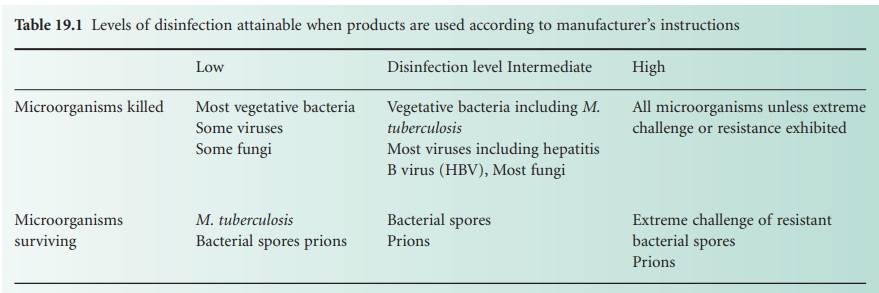Definitions - Chemical Disinfectants, Antiseptics And Preservatives
| Home | | Pharmaceutical Microbiology | | Pharmaceutical Microbiology |Chapter: Pharmaceutical Microbiology : Chemical Disinfectants, Antiseptics And Preservatives
Disinfection is the process of removing microorganisms, including pathogens, from the surfaces of inanimate objects. The British Standards Institution (BSI) further defines disinfection as not necessarily killing all microorganisms.
DEFINITIONS
A)
Disinfectant
And Disinfection
Disinfection is the process of removing
microorganisms, including pathogens, from the surfaces of inanimate objects.
The British Standards Institution (BSI) further defines disinfection as not
necessarily killing all microorganisms but reducing them to a level acceptable
for a defined purpose, for example, a level that is harmful neither to health
nor to the quality of perishable goods. Chemical disinfectants are capable of different
levels of action (Table 19.1).
The term high-level disinfection indicates destruction of
all microorganisms but not necessarily bacterial spores; intermediate-level disinfection indicates
destruction of all vegetative bacteria including Mycobacterium tuberculosis but may exclude some
resistant viruses and fungi and implies little or no sporicidal activity; low-level disinfection can destroy most vegetative
bacteria, fungi and viruses, but this will not include spores and some of the
more resistant microorganisms. Some high-level disinfectants have good
sporicidal activity and are described as liquid chemical sterilants or chemosterilants to indicate that they can effect a
complete kill of all microorganisms, as in sterilization. In defining each of
these disinfection levels the activity and outcome is determined by correct use
of the disinfectant product in regard to concentration, time of contact and
prevailing environmental conditions as described in this article series.

B)
Antiseptic
And Antisepsis
Antisepsis is defined as destruction or inhibition of microorganisms on living
tissues having the effect of limiting or preventing the harmful results of
infection. It is not a synonym for disinfection (BSI). The chemicals used are
applied to skin and mucous membranes, so as well as having adequate
antimicrobial activity they must not be toxic or irritating for these tissues.
Antiseptics are mostly used to reduce the microbial population on the skin
before surgery or on the hands to help prevent spread of infection by this
route. Antiseptics are sometimes formulated as products containing significantly
lower concentrations of agents used for disinfection.
C) Preservative And Preservation
Preservatives are included in
pharmaceutical and many other types of formulations, both to prevent microbial
spoilage of the product and to minimize the risk to the consumer of acquiring
an infection when the preparation is administered. Preservatives must be able
to limit proliferation of microorganisms that may be introduced unavoidably
into non-sterile products such as oral and topical medications during their
manufacture and use. In sterile products, where multiuse preparations remain
available, preservatives should kill any microbial contaminants introduced
inadvertently during use. It is essential that a preservative is not toxic in
relation to the intended route of administration of the preserved preparation.
Preservatives tend to be employed at very low concentrations and consequently
levels of antimicrobial action also tend to be of a lower order than for
disinfect-ants or antiseptics. This is illustrated by the European Pharmacopoeia requirements for
preservative efficacy where a degree of bactericidal activity is necessary,
although this should be obtained within a few hours or over several days of
microbial challenge depending on the type of product to be preserved.
Related Topics
